The Rise of Commercial Forestry – Concept & Notes PDF
Topic & sub-topics covered: The Rise of Commercial Forestry and MCQs Questions: Forest Society and Colonialism (All single detail notes are exam-oriented).
We have discussed in-depth and exam-oriented pointers that can be asked in the board exam of class 9th about the “The Rise of Commercial Forestry” from the NCERT History notes for class 9th chapter 4th “Forest Society and Colonialism“.
Download the NCERT History for Class 9th Chapter 4 Forest Society and Colonialism Notes PDF
NCERT History for Class 9th Chapter 4_ Forest Society and Colonialism Notes & MCQ’s Question-Answer
Preparing for Class 9 History? Chapter 4 Forest Society and Colonialism is an important topic that explains how colonial rule transformed forests, the lives of people who depended on them, and the environment itself. To make your preparation easier, we’ve created well-structured notes that highlight key events, important terms, and exam-oriented points in a simple way. With these notes, you can revise quickly and understand concepts like Deforestation, shifting cultivation, colonial policies, and resistance by forest communities. Download the NCERT History Class 9 Chapter 4 Forest Society and Colonialism Notes PDF and get everything you need for clear, focused exam preparation in one place.
The Rise of Commercial Forestry

1. Need for Forest Control:
- British needed forests mainly for ships and railways.
- They feared that local people’s use and reckless felling by traders would destroy forests.
2. Role of Dietrich Brandis:
- British invited German expert Dietrich Brandis to advise on forest management.
- He became the first Inspector General of Forests in India.
- Brandis Emphasised:
a. A proper system of forest management.
b. Training people in the science of conservation.
c. Legal framework to regulate forest use.
3. Measures Introduced:
- Rules were framed to regulate use of forest resources.
- Tree felling and grazing restricted to preserve timber.
- Punishments for those who cut trees without permission.
- Indian Forest Service established in 1864.
- Indian Forest Act passed in 1865 (later amended in 1878 & 1927).
- Imperial Forest Research Institute set up at Dehradun in 1906.
4. Scientific Forestry:
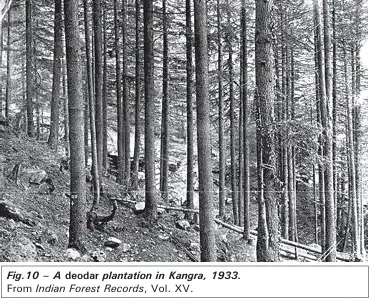
- Introduced as a new system of forest management.
- Natural forests with mixed trees were cut down.
- Replaced by plantations of a single tree species in straight rows.
- Forest officials:
a. Surveyed forests and estimated areas.
b. Made working plans to decide how much area to cut yearly.
c. Planned replanting so the cycle of cutting could continue. - Today, ecologists feel this system was not truly scientific, as it destroyed biodiversity.
5. Forest Acts:
- 1865 Indian Forest Act: First legal framework.
- 1878 Amendment: Forests classified into three categories:
a. Reserved Forests – Best forests, strictest control, villagers barred from use.
b. Protected Forests – Limited access.
c. Village Forests – Villagers allowed for basic needs (fuel, house-building). - 1927 Amendment: Strengthened forest laws further.
6. Key Exam Insights:
- Brandis → Inspector General, 1864.
- Indian Forest Service → 1864; Act → 1865; Research Institute → 1906.
- Scientific forestry → monoculture plantations replacing natural forests.
- 1878 Act → Reserved, Protected, Village Forests (Reserved = most important).

How were the Lives of People Affected?
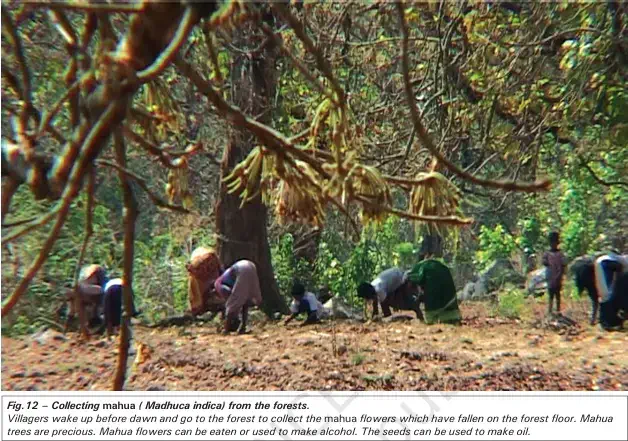
1. Different Views of Forests:
- Villagers’ view:
a. Needed forests with mixed species to meet daily needs: fuel, fodder, leaves, fruits, etc. - Forest Department’s view:
a. Wanted tall, straight, hardwood trees for ships and railways.
b. Promoted teak and sal, while cutting other species.
2. Uses of Forest Products by Villagers:
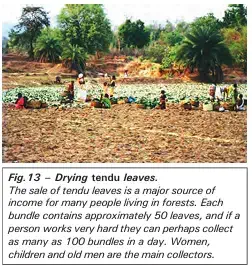
- Food & Nutrition:
a. Fruits and tubers – nutritious, especially before harvest. - Medicine:
a. Herbs used as traditional medicines. - Agriculture:
a. Wood used for yokes and ploughs. - Other Essentials:
a. Bamboo – fences, baskets, umbrellas.
b. Dried scooped-out gourd – used as portable water bottle.
c. Leaves – stitched into disposable plates & cups.
d. Siadi (Bauhinia vahlii) creeper – for ropes.
e. Semur (silk-cotton tree) bark – used to grate vegetables.
f. Mahua tree fruit – oil for cooking & lamps.
3. Impact of the Forest Act on Villagers:
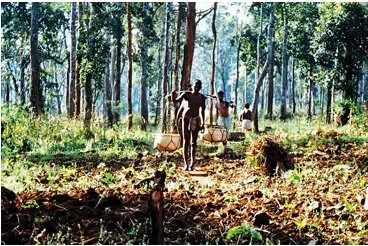
- Forest Act imposed severe hardships:
a. Daily activities made illegal – cutting wood, grazing cattle, collecting fruits/roots, hunting, fishing.
b. Villagers were forced to steal wood, risking punishment.
c. Forest guards exploited villagers, often demanding bribes.
d. Women collecting fuelwood were especially worried.
e. Police constables and forest guards also harassed people, demanding free food.
4. Key Exam Insights:
- Main Conflict: Villagers wanted diversity, but forest department promoted monocultures (teak, sal).
- Forest = Lifeline: Provided food, tools, medicine, utensils, fuel, ropes, plates, baskets.
- Forest Act Consequence: Turned villagers into criminals for their survival needs, leading to harassment, bribes, and hardships.
- Women’s Burden: Women faced maximum difficulty as they depended on forests for fuelwood.
How did Forest Rules Affect Cultivation?
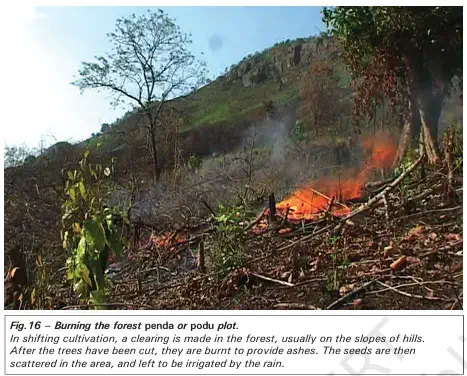
1. Shifting Cultivation – Traditional Practice:
- Known as swidden agriculture.
- Practiced in Asia, Africa, South America.
- Local names:
a. Southeast Asia → lading
b. Central America → milpa
c. Africa → chitemene / tavy
d. Sri Lanka → chena
e. India → dhya, penda, bewar, nevad, jhum, podu, khandad, kumri
2. Method of Shifting Cultivation:
- Forest patches cut and burnt in rotation.
- Seeds sown in ashes after first monsoon rains.
- Crops harvested by October–November.
- Plots cultivated for 2–3 years, then left fallow for 12–18 years for forest regeneration.
- Mixed crops grown:
a. Central India & Africa → millets
b. Brazil → manioc
c. Latin America → maize & beans
3. European Foresters’ Objections:
- Regarded shifting cultivation as harmful for forests.
- Believed it prevented growth of railway timber.
- Burning forests posed danger of spreading flames, destroying valuable timber.
4. Administrative Problems:
- Shifting cultivation made it hard to calculate taxes.
5. Colonial Government Action:
- Shifting cultivation banned.
- Communities forcibly displaced from forests.
- Consequences:
a. Some people had to change occupations.
b. Some communities resisted through rebellions (big and small).
6. Key Exam Insights:
- Shifting cultivation = traditional, eco-friendly, diverse crop practice but colonial rulers saw it as destructive.
- Conflict: Villagers needed subsistence; British wanted timber, revenue, control.
- Impact: Loss of livelihood, displacement, cultural disruption, rebellions.
Who could Hunt?

1. Hunting Before Colonial Forest Laws:
- Forest dwellers depended on hunting deer, partridges, small animals for survival.
- This was a customary right before the laws.
2. Impact of Forest Laws:
- Customary hunting banned.
- People caught hunting were punished for poaching.
- This led to loss of livelihood and food sources for forest communities.
3. Hunting as a Sport under Colonial Rule:
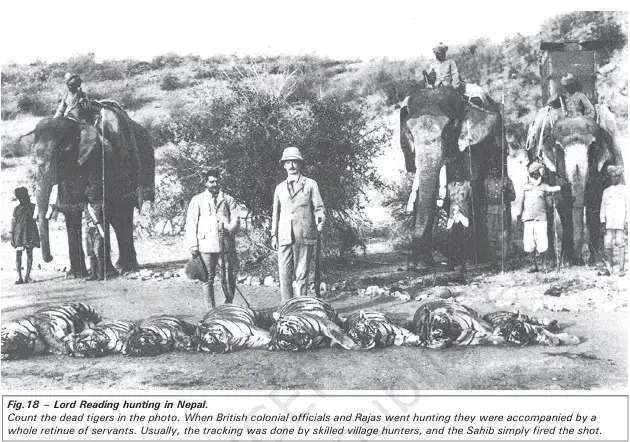
- Hunting of big game (tigers, leopards, wolves) turned into a sport.
- Hunting had been part of royal culture in Mughal courts.
- But under the British, scale of hunting increased massively, causing near extinction of species.
4. British Justification for Hunting:
- British saw large animals as symbols of a wild, savage society.
- Claimed that killing “dangerous” animals would civilise India.
- Rewards given for killing: Tigers, wolves, leopards (seen as threats to cultivators).
5. Alarming Numbers of Kills (1875–1925):
- Tigers → Over 80,000 killed.
- Leopards → Over 150,000 killed.
- Wolves → Over 200,000 killed.
6. Trophy Hunting:
- Tiger became a sporting trophy.
- Example cases:
a. Maharaja of Sarguja → shot 1,157 tigers & 2,000 leopards (till 1957).
b. George Yule (British administrator) → killed 400 tigers.
7. Forest Areas Reserved for Hunting:
- Certain forest zones were exclusively reserved for hunting.
8. Beginning of Conservation Awareness:
- Initially focus was on killing for rewards and trophies.
- Later, environmentalists and conservators argued that animal species should be protected, not exterminated.
9. Key Exam Takeaways:
- Conflict: Forest dwellers lost hunting rights, while colonial rulers promoted hunting as sport.
- Double standard: People punished for hunting small animals, but British/royals hunted large animals in thousands.
- Impact: Near extinction of species, ecological imbalance.
- Turning point: Rise of environmentalist thought later in colonial & post-colonial times.
New Trades, New Employments and New Services
1. New Opportunities in Forest Trade:
- After the forest department took control, some people benefited through new trades.
- Many communities left traditional occupations and turned to forest product trading.
- This shift happened globally, not just in India.
2. Example from Brazil (Global Context):
- Mundurucu peoples (Brazilian Amazon):
a. Originally cultivated manioc on high ground.
b. With rising demand for rubber (mid-19th century), they started collecting latex from wild rubber trees.
c. Gradually moved to trading posts and became dependent on traders.
3. Forest Trade in Medieval India:
- Trade in forest products existed from the medieval period onwards.
- Adivasi communities traded in:
a. Elephants, hides, horns, silk cocoons, ivory, bamboo, spices, fibres, grasses, gums, resins. - Trade often carried out through nomadic communities like the Banjaras.
4. British Control over Trade:
- Under British rule, trade became highly regulated.
- Large European trading firms got exclusive rights to trade forest products in specific areas.
- Restrictions imposed on local people:
a. Grazing restricted.
b. Hunting restricted.
5. Impact on Nomadic and Pastoral Communities:
- Communities like Korava, Karacha, Yerukula (Madras Presidency) lost traditional livelihoods.
- Some were branded as ‘criminal tribes’.
- Forced into factories, mines, plantations under government control.
6. Plantation Labour in Assam:
- Forest communities recruited for tea plantations in Assam.
a. Men & women from Santhals, Oraons (Jharkhand), Gonds (Chhattisgarh). - Faced low wages and very bad working conditions.
- Could not easily return home, remained trapped in plantation system.
7. Key Insights:
- Trade created new jobs but also caused loss of traditional livelihoods.
- British monopoly in trade → exploitation of resources + exclusion of locals.
- Nomadic/pastoral groups suffered most, many criminalised.
- Plantation system = harsh, exploitative labour conditions, especially in Assam.
- “New employment” ≠ better living standards.
New words
- Scientific forestry – A system of cutting trees controlled by the forest department, in which old trees are cut and new ones planted.
Source C: The Baigas of Central India
1. Who are Baigas?
- A forest community living in Central India.
2. Year & Event:
- In 1892, their practice of shifting cultivation was banned by the government.
3. Petition to the Government (1892):
- Complained of starvation: no foodgrain in possession.
- Only wealth = their axe.
- No clothes, forced to spend cold nights by the fireside.
- Claimed they were “dying for want of food”.
- Could not move elsewhere → bound to their land.
4. Grievances Highlighted:
- Asked: “What fault have we done?” → showing innocence & injustice.
- Prisoners in jail were better fed than Baigas.
- Cultivators of grass kept their holdings, but forest cultivators like Baigas lost their rights.
- Asserted their historical rights: “We have lived here for generations past.”
5. Key Insight:
- Shows the hardship, loss of livelihood, and neglect faced by Adivasi communities when traditional cultivation was banned.
Source D: Rubber Extraction in Putumayo (Amazon Region)
1. Location & Company:
- Rubber extraction in Putumayo region (Amazon).
- Run by the Peruvian Rubber Company with British & Peruvian interests.
2. Forced Labour of Huitotos:
- Rubber collection relied on forced labour of local Indians (Huitotos).
3. Time Period & Output:
- 1900–1912 → 4000 tons of rubber extracted.
- Linked to decrease of ~30,000 Indians due to:
a. Torture
b. Disease
c. Flight (escaping oppression).
4. Conditions of Work:
- Described as horrific worldwide in plantations.
5. Example of Brutality:
- Manager summoned hundreds of Indians to the station.
- He used carbine (gun) & machete to massacre them.
- 150 corpses (men, women, children) left on ground.
- Survivors were piled with the dead and burned alive.
- Manager’s words: “I want to exterminate all the Indians who do not obey my orders about the rubber.”
6. Key Insight:
- Reflects extreme violence, exploitation, and dehumanisation under colonial economic interests.
- Rubber trade = profits for Europeans but genocide for indigenous peoples.
7. Overall Takeaways:
- Source C (India): Shows economic exploitation & neglect → traditional rights denied.
- Source D (Amazon): Shows violent coercion & genocide → profits built on extreme oppression.
- Both highlight that colonial forest policies & global plantation systems caused misery instead of development for indigenous communities.
Next & Previous Topics of NCERT/CBSE History Class 9 Chapter 4: Forest Society and Colonialism
| Topics No. | Topics Name |
|---|---|
| 1 | Why Deforestation? |
| 2 | The Rise of Commercial Forestry |
| 3 | Rebellion in the Forest |
| 4 | Forest Transformations in Java |
MCQs on NCERT History Class 9 Chapter 4 Topic – The Rise of Commercial Forestry
Here are the top exam-oriented MCQ-type questions on “The Rise of Commercial Forestry” that you should prepare for your CBSE or state board exams:
Question 1. Why did the British need forests in India?
a) For making furniture
b) For building ships and railways
c) For exporting timber to Europe
d) For fuel supply
Answer: b) For building ships and railways
Question 2. Who was invited by the British as the first Inspector General of Forests in India?
a) George Yule
b) Verrier Elwin
c) Dietrich Brandis
d) Robert Clive
Answer: c) Dietrich Brandis
Question 3. In which year was the Indian Forest Service set up?
a) 1857
b) 1864
c) 1878
d) 1906
Answer: b) 1864
Question 4. The Indian Forest Act was first passed in which year?
a) 1865
b) 1878
c) 1906
d) 1927
Answer: a) 1865
Question 5. Where was the Imperial Forest Research Institute established in 1906?
a) Shimla
b) Dehradun
c) Nagpur
d) Kolkata
Answer: b) Dehradun
Question 6. What was the method of replacing natural forests with one type of tree in straight rows called?
a) Plantation
b) Shifting cultivation
c) Afforestation
d) Community forestry
Answer: a) Plantation
Question 7. How many categories of forests were introduced under the Forest Act of 1878?
a) Two
b) Three
c) Four
d) Five
Answer: b) Three
Question 8. Which were considered the best forests under the 1878 Forest Act?
a) Protected forests
b) Reserved forests
c) Village forests
d) Community forests
Answer: b) Reserved forests
Question 9. Villagers wanted forests with –
a) Tall and straight trees
b) Only teak and sal
c) Mixture of species
d) Bamboo plantations
Answer: c) Mixture of species
Question 10. Which trees were especially promoted by the forest department?
a) Mango and neem
b) Bamboo and coconut
c) Teak and sal
d) Peepal and banyan
Answer: c) Teak and sal
Question 11. The thorny bark of the semur (silk-cotton) tree was used for –
a) Making ropes
b) Grating vegetables
c) Lighting lamps
d) Stitching leaves
Answer: b) Grating vegetables
Question 12. Which product of the mahua tree was used by villagers?
a) Rope
b) Oil
c) Baskets
d) Medicines
Answer: b) Oil
Question 13. Shifting cultivation is also known as –
a) Plantation farming
b) Swidden agriculture
c) Terrace farming
d) Dry farming
Answer: b) Swidden agriculture
Question 14. What is shifting cultivation called in Sri Lanka?
a) Milpa
b) Chena
c) Bewar
d) Tavy
Answer: b) Chena
Question 15. How many years were shifting cultivation plots usually left fallow?
a) 2–5 years
b) 6–10 years
c) 12–18 years
d) 20–25 years
Answer: c) 12–18 years
Question 16. Why did the British ban shifting cultivation?
a) It wasted water
b) It destroyed timber and made tax collection difficult
c) It was unhealthy
d) It used too much land
Answer: b) It destroyed timber and made tax collection difficult
Question 17. Before the Forest Acts, many forest dwellers survived by –
a) Hunting
b) Rubber tapping
c) Mining
d) Fishing only
Answer: a) Hunting
Question 18. How many tigers were killed for rewards between 1875–1925?
a) 50,000
b) 80,000
c) 1,00,000
d) 1,57,000
Answer: b) 80,000
Question 19. Who killed 400 tigers during colonial rule?
a) Maharaja of Sarguja
b) Dietrich Brandis
c) George Yule
d) Lord Dalhousie
Answer: c) George Yule
Question 20. The Maharaja of Sarguja shot –
a) 1,157 tigers and 2,000 leopards
b) 800 tigers and 1,500 leopards
c) 2,000 tigers and 1,157 leopards
d) 500 tigers and 1,000 leopards
Answer: a) 1,157 tigers and 2,000 leopards
Question 21. Which community in Brazil collected latex from wild rubber trees?
a) Mundurucu
b) Banjaras
c) Korava
d) Yerukula
Answer: a) Mundurucu
Question 22. Which nomadic community in India traded elephants, hides, and silk cocoons?
a) Gonds
b) Banjaras
c) Korava
d) Karacha
Answer: b) Banjaras
Question 23. Which communities in Madras Presidency lost their livelihoods due to forest restrictions?
a) Mundurucu
b) Korava, Karacha, Yerukula
c) Oraons and Santhals
d) Baigas
Answer: b) Korava, Karacha, Yerukula
Question 24. Where were Santhals, Oraons, and Gonds recruited for plantation work?
a) Assam tea plantations
b) Bengal indigo plantations
c) Deccan cotton farms
d) Nilgiri coffee plantations
Answer: a) Assam tea plantations
Question 25. Which forest community of Central India petitioned the government in 1892?
a) Korava
b) Baigas
c) Mundurucu
d) Oraons
Answer: b) Baigas
Question 26. What was the main grievance of the Baigas after shifting cultivation was stopped?
a) Lack of clothing
b) Starvation due to no foodgrain
c) Excessive taxes
d) Loss of houses
Answer: b) Starvation due to no foodgrain
Question 27. In the Putumayo region, which local group was forced into rubber extraction?
a) Oraons
b) Huitotos
c) Banjaras
d) Gonds
Answer: b) Huitotos
Question 28. Between 1900–1912, how many Indians (Huitotos) died in Putumayo due to rubber extraction conditions?
a) 10,000
b) 20,000
c) 30,000
d) 50,000
Answer: c) 30,000

